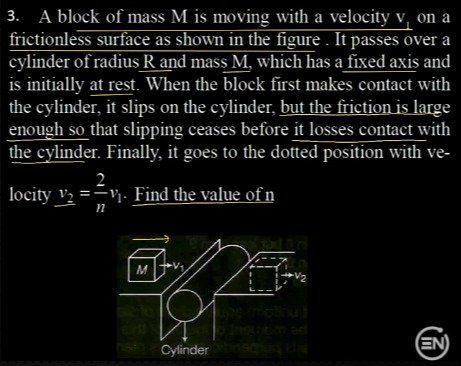Question
Question: A block of mass M is moving with a velocity \(v_1\) on a frictionless surface as shown in the figure...
A block of mass M is moving with a velocity v1 on a frictionless surface as shown in the figure. It passes over a cylinder of radius R and mass M, which has a fixed axis and is initially at rest. When the block first makes contact with the cylinder, it slips on the cylinder, but the friction is large enough so that slipping ceases before it losses contact with the cylinder. Finally, it goes to the dotted position with velocity v2=n2v1. Find the value of n.

n = 3
Solution
We analyze the system by conserving the angular momentum about the cylinder’s center. Before contact, the only contribution is from the block. Assuming the block’s line of motion is tangent to the cylinder (at a distance R from its center), the block’s initial angular momentum is
Li=Mv1R.After rolling without slipping is established, the block and cylinder satisfy the non‐slipping condition
v2=ωR.Now, the block (mass M) has translational angular momentum about the center
Lblock=Mv2R,and the cylinder (mass M, moment of inertia I=21MR2 for a uniform cylinder) has rotational angular momentum
Lcyl=Iω=21MR2Rv2=21MRv2.Thus, the total final angular momentum is
Lf=Lblock+Lcyl=MRv2+21MRv2=23MRv2.Assuming no net external torque about the center (since the support forces have zero moment about the fixed center), equate the initial and final angular momenta:
MRv1=23MRv2⟹v2=32v1.Since the problem states v2=n2v1, we must have
n2=32⟹n=3.